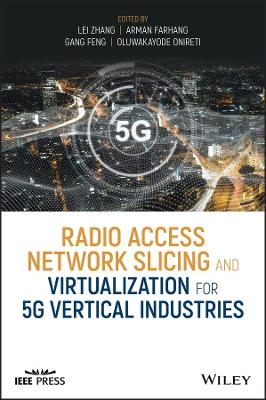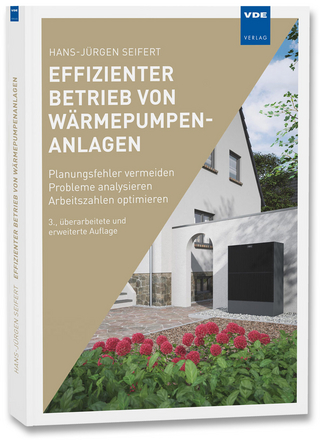
Radio Access Network Slicing and Virtualization for 5G Vertical Industries
Wiley-IEEE Press (Verlag)
978-1-119-65238-0 (ISBN)
Radio Access Network Slicing and Virtualization for 5G Vertical Industriesprovides readers with a comprehensive and authoritative examination of crucial topics in the field of radio access network (RAN) slicing. Learn from renowned experts as they detail how this technology supports and applies to various industrial sectors, including manufacturing, entertainment, public safety, public transport, healthcare, financial services, automotive, and energy utilities.
Radio Access Network Slicing and Virtualization for 5G Vertical Industries explains how future wireless communication systems must be built to handle high degrees of heterogeneity, including different types of applications, device classes, physical environments, mobility levels, and carrier frequencies. The authors describe how RAN slicing can be utilized to adapt 5G technologies to such wide-ranging circumstances.
The book covers a wide range of topics necessary to understand RAN slicing, including:
Physical waveforms design
Multiple service signals coexistence
RAN slicing and virtualization
Applications to 5G vertical industries in a variety of environments
This book is perfect for telecom engineers and industry actors who wish to identify realistic and cost-effective concepts to support specific 5G verticals. It also belongs on the bookshelves of researchers, professors, doctoral, and postgraduate students who want to identify open issues and conduct further research.
LEI ZHANG, PhD, is Senior Lecturer at the University of Glasgow, UK. He received his PhD degree from the University of Sheffield, UK. He was a research fellow in the 5G Innovation Centre (5GIC) at the Institute of Communications (ICS), University of Surrey, UK. His research interests include wireless communication systems and networks, blockchain technology, radio access network slicing (RAN slicing), Internet of Things (IoT), multi-antenna signal processing, MIMO systems, and many more. ARMAN FARHANG, PhD, received his PhD from the Trinity College in Dublin, Ireland. He is currently an Assistant Professor in the Department of Electronic Engineering at Maynooth University, Ireland. His research interests and activities are in the broad area of signal processing for communications, waveform design, signal processing for multiuser and multiple antenna systems. GANG FENG, PhD, is a Professor at the University of Electronic Science and Technology of China (UESTC), China. He received his MEng degree in Electronic Engineering from UESTC and his PhD in information engineering from the Chinese University of Hong Kong. OLUWAKAYODE ONIRETI, PhD, is a Lecturer at the University of Glasgow, UK. He received an MSc degree in mobile and satellite communication and a PhD in Electronics Engineering from the University of Surrey, Guildford, UK.
About the Editors xiii
Preface xvii
List of Contributors xxiii
List of Abbreviations xxvii
Part I Waveforms and Mixed-Numerology 1
1 ICI Cancellation Techniques Based on Data Repetition for OFDM Systems 3
Miaowen Wen, Jun Li, Xilin Cheng and Xiang Cheng
1.1 OFDM History 3
1.2 OFDM Principle 4
1.2.1 Subcarrier Orthogonality 4
1.2.2 Discrete Implementation 5
1.2.3 OFDM in Multipath Channel 6
1.3 Carrier Frequency Offset Effect 8
1.3.1 Properties of ICI Coefficients 9
1.3.2 Carrier-to-Interference Power Ratio 9
1.4 ICI Cancellation Techniques 11
1.4.1 One-Path Cancellation with Mirror Mapping 11
1.4.1.1 MSR Scheme 12
1.4.1.2 MCSR Scheme 13
1.4.2 Two-Path Cancellation with Mirror Mapping 14
1.4.2.1 MCVT Scheme 15
1.4.2.2 MCJT Scheme 15
1.4.3 CIR Comparison 16
1.5 Experiment on Sea 17
1.5.1 Experiment Settings 18
1.5.2 Experiment Results 21
1.6 Summary 22
References 23
2 Filtered OFDM: An Insight into Intrinsic In-Band Interference 25
Juquan Mao, Lei Zhang and Pei Xiao
2.1 Introduction 25
2.1.1 Notations 26
2.2 System Model for f-OFDM SISO System 26
2.3 In-Band Interference Analysis and Discussion 30
2.3.1 Channel Diagonalization and In-Band Interference-Free Systems 30
2.3.2 In-Band Interference Power 31
2.3.3 In-Band Interference Mitigation: A Practical Approach for Choosing CR Length 32
2.3.4 An Alternative for In-Band Interference Mitigation: Frequency Domain Equalization (FDE) 33
2.3.4.1 Linear Equalizers 33
2.3.4.2 Nonlinear Equalizers 34
2.4 Numerical Results 34
2.4.1 Numerical Results for In-Band Interference 35
2.5 Conclusion 38
1.2 Appendix 38
1.2.1 Derivation of zk 38
2.3 Appendix 39
2.3.1 Proof of 𝚯preBeing a Strict Upper Triangle 39
3.4 Appendix 39
3.4.1 Proof of Property 2.A.2 39
References 40
3 Windowed OFDM for Mixed-Numerology 5G and Beyond Systems 43
Bowen Yang, Xiaoying Zhang, Lei Zhang, Arman Farhang, Pei Xiao and Muhammad Ali Imran
3.1 Introduction 43
3.2 W-OFDM System Model 45
3.2.1 Single Numerology System Model 46
3.2.2 System Model for Mixed Numerologies 48
3.3 Inter-numerology Interference Analysis 50
3.3.1 Inter-numerology Interference Analysis for Numerology 1 50
3.3.2 Inter-numerology Interference Analysis for Numerology 2 52
3.4 Numerical Results and Discussion 54
3.5 Conclusions 57
3.6 Derivation of (3.9) 57
3.7 Derivations of (3.28) 58
3.8 Derivations of (3.30) 59
References 59
4 Generalized Frequency Division Multiplexing: Unified Multicarrier Framework 63
Ahmad Nimr, Zhongju Li, Marwa Chafii and Gerhard Fettweis
4.1 Overview of MulticarrierWaveforms 63
4.1.1 Time–Frequency Representation 64
4.1.1.1 Discrete-Time Representation 65
4.1.1.2 Relation to Gabor Theory 66
4.1.2 GFDM As a FlexibleWaveform 66
4.1.2.1 GFDM with Multiple Prototype Pulses 67
4.1.3 Generalized Block-Based Multicarrier 68
4.1.3.1 Transmitter 69
4.1.3.2 Receiver 69
4.2 GFDM As a Flexible Framework 70
4.2.1 GFDM Representations 71
4.2.1.1 Filter Bank Representation 71
4.2.1.2 Vector Representation 71
4.2.1.3 2D-Block Representation 72
4.2.1.4 GFDM Matrix Structure 73
4.2.2 Architecture and Extended Flexibility 74
4.2.2.1 Alternative Interpretation of GFDM 75
4.2.2.2 Extended Flexibility 76
4.2.2.3 Flexible Hardware Architecture 76
4.3 GFDM for OFDM Enhancement 78
4.3.1 Transmitter 78
4.3.2 Receiver 79
4.3.2.1 LMMSE GFDM-Based Receiver 79
4.4 Conclusions 80
References 80
5 Filter Bank Multicarrier Modulation 83
Behrouz Farhang-Boroujeny
5.1 Introduction 83
5.1.1 Notations: 83
5.2 FBMC Methods 84
5.3 Theory 84
5.3.1 CMT 85
5.3.2 SMT 88
5.4 Prototype Filter Design 92
5.4.1 Prototype Filters for Time-Invariant Channels 92
5.4.2 Prototype Filters for Time-Varying Channels 93
5.5 Synchronization and Tracking Methods 94
5.5.1 Preamble Design 95
5.5.2 Channel Tracking 96
5.5.3 Timing Tracking 97
5.6 Equalization 97
5.7 Computational Complexity 98
5.8 Applications 98
References 99
6 Orthogonal Time–Frequency Space Modulation: Principles and Implementation 103
Arman Farhang and Behrouz Farhang-Boroujeny
6.1 Introduction 103
6.2 OTFS Principles 105
6.3 OFDM-Based OTFS 107
6.4 Channel Impact 108
6.5 Simplified Modem Structure 110
6.6 Complexity Analysis 113
6.7 Recent Results and Potential Research Directions 114
References 117
Part II RAN Slicing and 5G Vertical Industries 121
7 Multi-Numerology Waveform Parameter Assignment in 5G 123
Ahmet Yazar and Hüseyin Arslan
7.1 Introduction 123
7.1.1 Problem Definitions 125
7.1.2 Literature Review 126
7.2 Waveform Parameter Options 128
7.3 Waveform Parameter Assignment 130
7.4 Conclusion 132
References 132
8 Network Slicing with Spectrum Sharing 137
Yue Liu, Xu Yang and Laurie Cuthbert
8.1 The Need for Spectrum Sharing 137
8.2 Historical Approaches to Spectrum Sharing 139
8.2.1 Classifications of Spectrum Sharing 140
8.2.1.1 Orthogonality 140
8.2.1.2 Sharing Rights 141
8.2.1.3 Allocation of Resources 142
8.3 Network Slicing in the RAN 144
8.4 Radio Resource Allocation that Considers Spectrum Sharing 146
8.4.1 Example Radio Resource Allocation for Sharing Through Network Slicing 147
8.4.2 Other Considerations 153
8.5 Isolation 156
8.5.1 Example Isolation Results Using CAC 157
8.5.1.1 Type A: Baseline – CACWithout Network Isolation and Without Protection for Existing Users 158
8.5.1.2 Type B: Optimum Types – B1 and B2 158
8.5.1.3 Type C: Without Compensation – C1 and C2 159
8.6 Conclusions 162
Acknowledgments 163
References 163
9 Access Control and Handoff Policy Design for RAN Slicing 167
Yao Sun, Lei Zhang, Gang Feng and Muhammad Ali Imran
9.1 A Framework of User Access Control for RAN Slicing 167
9.1.1 System Model for RAN Slicing 168
9.1.2 UE Association Problem Description 170
9.1.3 Admission Control Mechanisms Design for RAN Slicing 170
9.1.3.1 Optimal QoS AC Mechanism 171
9.1.3.2 Num-AC Mechanism 176
9.1.4 Experiments, Results, and Discussions 177
9.2 Smart Handoff Policy Design for RAN Slicing 179
9.2.1 RAN Slice Based Mobile Network Model 179
9.2.2 Multi-Agent Reinforcement Learning Based Handoff Framework 181
9.2.3 LESS Algorithm for Target BS and NS Selection 181
9.2.3.1 q-Value Update Policy 182
9.2.3.2 Optimal Action Policy 183
9.2.4 Experiment, Results, and Discussions 184
9.3 Summary 186
References 186
10 Robust RAN Slicing 189
Ruihan Wen and Gang Feng
10.1 Introduction 189
10.2 Network Model 190
10.2.1 Slice Failure Detection Process 190
10.2.2 System Model 191
10.3 Robust RAN Slicing 193
10.3.1 Failure Recovery Problem Formulation 193
10.3.2 Robust RAN Slicing Problem Formulation 195
10.3.3 Variable Neighborhood Search Based Heuristic for Robust RAN Slicing 196
10.4 Numerical Results 199
10.4.1 Performance Metrics 199
10.4.2 Simulation Scenarios and Settings 200
10.4.3 Results 201
10.5 Conclusions and Future Work 206
References 206
11 Flexible Function Split Over Ethernet Enabling RAN Slicing 209
Ghizlane Mountaser and Toktam Mahmoodi
11.1 Flexible Functional Split Toward RAN Slicing 209
11.1.1 Full Centralization and CPRI 209
11.1.2 RAN Functional Split 210
11.1.3 Flexible Functional Split as RAN Slicing Enabler 213
11.2 Fronthaul Reliability and Slicing by Deploying Multipath at the Fronthaul 213
11.2.1 Packet-Based Fronthaul 213
11.2.2 Multipath Packet-Based Fronthaul for Enhancing Reliability 213
11.2.3 Slicing Within Multipath Fronthaul 214
11.3 Experimentation Results Evaluation of Flexible Functional Split for RAN Slicing 214
11.3.1 Experimental Setup 214
11.3.2 Evaluation and Discussion of the Results 215
11.4 Simulation Results Analysis of Multipath Packet-Based Fronthaul for RAN Slicing 217
11.4.1 Simulation System Model 217
References 219
12 Service-Oriented RAN Support of Network Slicing 221
Wei Tan, Feng Han, Yinghao Jin and Chenchen Yang
12.1 Introduction 221
12.2 General Concept and Principles 222
12.2.1 Network Slicing Concepts 223
12.2.2 Overall RAN Subsystem 224
12.2.3 Key Principles of Network Slicing in RAN 225
12.3 RAN Subsystem Deployment Scenarios 227
12.4 Key Technologies to Enable Service-Oriented RAN Slicing 229
12.4.1 Device Awareness of RAN Part of Network Slice 230
12.4.2 Slice-Specific RAN Part of Network Slice 232
12.4.3 Mission-Driven Resource Utilization, Sharing, and Aggregation 234
12.4.4 Slice-Aware Connected UE Mobility 235
12.4.5 Slice-Level Handlings for Idle/Inactive UEs 237
12.5 Summary 237
References 238
13 5G Network Slicing for V2X Communications: Technologies and Enablers 239
Claudia Campolo, Antonella Molinaro and Vincenzo Sciancalepore
13.1 Introduction 239
13.2 Vehicular Applications 240
13.3 V2X Communication Technologies 241
13.3.1 The C-V2X Technology 242
13.3.1.1 The PC5 Radio Interface 242
13.3.1.2 The LTE-Uu Interface 242
13.3.1.3 Core Network 243
13.3.2 C-V2X Toward 5G 243
13.3.2.1 Radio Interface 243
13.3.2.2 Core Network 244
13.4 Cloudification in V2X Environments 245
13.4.1 The Role of MEC 245
13.4.2 ETSI MEC-Based Programmable Interfaces 246
13.4.3 MEC-Based Support for V2X Applications 247
13.5 Transport and Tunneling Protocol for V2X 248
13.5.1 GTP-U Encapsulation 248
13.5.2 Segment Routing v6 248
13.5.3 Scalability and Flexibility in SRv6 250
13.6 Network Slicing for V2X 251
13.6.1 3GPP Specifications 251
13.6.2 Literature Overview 252
13.7 Lessons Learnt and Guidelines 255
13.7.1 Slice Mapping and Identification 255
13.7.2 Multi-tenancy Management 255
13.7.3 Massive Communications 255
13.7.4 Transparent Mobility 256
13.7.5 Isolation 256
13.8 Conclusions 256
References 256
14 Optimizing Resource Allocation in URLLC for Real-Time Wireless Control Systems 259
Bo Chang, Liying Li and Guodong Zhao
14.1 Introduction 259
14.2 System Model with Latency and Reliability Constraints 261
14.2.1 Wireless Control Model 262
14.2.2 Wireless Communication Model 266
14.3 Communication-Control Co-Design 267
14.3.1 Communication Constraint 267
14.3.2 Control Constraint 268
14.3.3 Problem Formulation 269
14.4 Optimal Resource Allocation for The Proposed Co-Design 270
14.4.1 Relationship Between Control and Communication 270
14.4.2 Optimal Resource Allocation 271
14.4.2.1 Problem Conversion 271
14.4.2.2 Problem Solution 272
14.4.3 Optimal Control Convergence Rate 273
14.5 Simulations Results 273
14.5.1 Control Performance 274
14.5.2 Communication Performance 276
14.6 Conclusions 279
References 279
Index 283
| Erscheinungsdatum | 16.01.2021 |
|---|---|
| Reihe/Serie | IEEE Press |
| Sprache | englisch |
| Maße | 170 x 244 mm |
| Gewicht | 737 g |
| Themenwelt | Technik ► Elektrotechnik / Energietechnik |
| Technik ► Nachrichtentechnik | |
| ISBN-10 | 1-119-65238-3 / 1119652383 |
| ISBN-13 | 978-1-119-65238-0 / 9781119652380 |
| Zustand | Neuware |
| Informationen gemäß Produktsicherheitsverordnung (GPSR) | |
| Haben Sie eine Frage zum Produkt? |
aus dem Bereich


